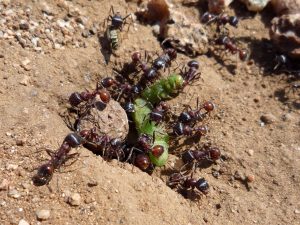
Ants are prevalent throughout the world. The industrious insects work together to form a colony. Many people are fascinated by ants and all that they do. Here are 10 interesting facts about ants.
1. Queens Rule the Colony
The queen’s primary purpose is to lay eggs for the colony. The worker ants will bring the queen food and take care of her needs. If they need to evacuate, the ants will even carry the queen so that she does not move. Queens can live up to 15 years.
2. Tons of Ants
There are over 10,000 trillion ants throughout the world. There are estimates that the total weight of ants throughout the world is about equal to the total weight of humans in the world.
3. 12,000 Species of Ants
There are 12,000 species of ants throughout the world. Some ants are aggressive like the fire ant and army ant, while others are more focused on building a colony like a harvester ant or black garden ant.
4. Ants Vary in Size
The carebara atoma are the world’s smallest ants. They are about one millimeter long. The biggest ant is the camponontus gigas and their heads can be up to seven millimeters wide.
5. Lots of Eggs
A queen ant can lay up to 300,000 eggs in just a few days. Since queen ants can live up to 15 years that means she can lay millions and millions of eggs while she is alive.
6. Ants Have Super Colonies
Ant colonies can vary in size from species to species. However, there are super colonies that can have several queens and a large number of worker ants. According to
Wikipedia on ants, the largest ant colony is in Southern Europe that one super ant colony had millions of nests stretched along 3,731 miles of shore.
7. Ants Can Carry 3 Times Their Own Weight
Although very small, ants are very strong. They can carry up to three times their own weight. Ants will also work together to carry heavy objects.
8. Ants Have Hive Minds
Ants have a unique hive mind that allows them to communicate with each other and work together. The idea of a hive mind has been the basis of many science fiction stories, but ants seem to pull it off without any of the related fears and concerns.
Although ants are interesting creatures, they are not as fascinating when they are invading your home or kitchen. It is important to stop ants as soon as you see them since more are sure to follow. The experts at EcoTek Pest and Termite Control
can stop ants from invading your home.
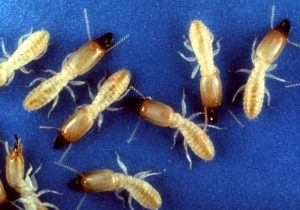 There are a wide variety of termites in the United States. However, in the southeastern portion, the majority of termites are the Eastern Subterranean termites. These termites have different characteristics than other termites. It helps to understand their habits so you know the best treatment for the Eastern Subterranean Termite.
These termites build their colonies underground through a system of tunnels. They rarely have the termite mounds, so it can be difficult to spot one in your yard. These tunnels can extend several feet from the primary nests and allow the works to go and find food and bring it back to the colony.
Eastern subterranean termites prefer to eat dead wood. This means they may be eating old trees or tree stumps on your property. They may also go after wood piles, which is why you should never stack a wood pile against your home. They will also eat the wood inside of your home.
Since they are eating the wood inside of your home and eating along the grain of the wood, you may not notice them right away. If you do notice damage it will be in long grooves that go with the grain. Other signs that they are in your home include the mud tubes that they build up the side of your foundation until they can reach the wood of your home. These tubes are about the width of a pencil and if you see them, you need to deal with termites right away.
Subterranean termite colonies will travel in search of more wood to eat. In addition to sending out winged termites to start new colonies, the entire colony will travel through tunnels to a new food source. Often the queen is carried by worker ants.
Termites are quite common in North Carolina and a termite study in 2008 showed that the average property in the state has about ten termite colonies in it. The key is to protect the termites from finding your home and making it their feeding ground. You can do this through several steps such as repairing leaky pipes, but the most effective thing is to monitor your property regularly and have a termite treatment if necessary.
There are a wide variety of termites in the United States. However, in the southeastern portion, the majority of termites are the Eastern Subterranean termites. These termites have different characteristics than other termites. It helps to understand their habits so you know the best treatment for the Eastern Subterranean Termite.
These termites build their colonies underground through a system of tunnels. They rarely have the termite mounds, so it can be difficult to spot one in your yard. These tunnels can extend several feet from the primary nests and allow the works to go and find food and bring it back to the colony.
Eastern subterranean termites prefer to eat dead wood. This means they may be eating old trees or tree stumps on your property. They may also go after wood piles, which is why you should never stack a wood pile against your home. They will also eat the wood inside of your home.
Since they are eating the wood inside of your home and eating along the grain of the wood, you may not notice them right away. If you do notice damage it will be in long grooves that go with the grain. Other signs that they are in your home include the mud tubes that they build up the side of your foundation until they can reach the wood of your home. These tubes are about the width of a pencil and if you see them, you need to deal with termites right away.
Subterranean termite colonies will travel in search of more wood to eat. In addition to sending out winged termites to start new colonies, the entire colony will travel through tunnels to a new food source. Often the queen is carried by worker ants.
Termites are quite common in North Carolina and a termite study in 2008 showed that the average property in the state has about ten termite colonies in it. The key is to protect the termites from finding your home and making it their feeding ground. You can do this through several steps such as repairing leaky pipes, but the most effective thing is to monitor your property regularly and have a termite treatment if necessary.  There are a wide variety of termites in the United States. However, in the southeastern portion, the majority of termites are the Eastern Subterranean termites. These termites have different characteristics than other termites. It helps to understand their habits so you know the best treatment for the Eastern Subterranean Termite.
These termites build their colonies underground through a system of tunnels. They rarely have the termite mounds, so it can be difficult to spot one in your yard. These tunnels can extend several feet from the primary nests and allow the works to go and find food and bring it back to the colony.
Eastern subterranean termites prefer to eat dead wood. This means they may be eating old trees or tree stumps on your property. They may also go after wood piles, which is why you should never stack a wood pile against your home. They will also eat the wood inside of your home.
Since they are eating the wood inside of your home and eating along the grain of the wood, you may not notice them right away. If you do notice damage it will be in long grooves that go with the grain. Other signs that they are in your home include the mud tubes that they build up the side of your foundation until they can reach the wood of your home. These tubes are about the width of a pencil and if you see them, you need to deal with termites right away.
Subterranean termite colonies will travel in search of more wood to eat. In addition to sending out winged termites to start new colonies, the entire colony will travel through tunnels to a new food source. Often the queen is carried by worker ants.
Termites are quite common in North Carolina and a termite study in 2008 showed that the average property in the state has about ten termite colonies in it. The key is to protect the termites from finding your home and making it their feeding ground. You can do this through several steps such as repairing leaky pipes, but the most effective thing is to monitor your property regularly and have a termite treatment if necessary.
There are a wide variety of termites in the United States. However, in the southeastern portion, the majority of termites are the Eastern Subterranean termites. These termites have different characteristics than other termites. It helps to understand their habits so you know the best treatment for the Eastern Subterranean Termite.
These termites build their colonies underground through a system of tunnels. They rarely have the termite mounds, so it can be difficult to spot one in your yard. These tunnels can extend several feet from the primary nests and allow the works to go and find food and bring it back to the colony.
Eastern subterranean termites prefer to eat dead wood. This means they may be eating old trees or tree stumps on your property. They may also go after wood piles, which is why you should never stack a wood pile against your home. They will also eat the wood inside of your home.
Since they are eating the wood inside of your home and eating along the grain of the wood, you may not notice them right away. If you do notice damage it will be in long grooves that go with the grain. Other signs that they are in your home include the mud tubes that they build up the side of your foundation until they can reach the wood of your home. These tubes are about the width of a pencil and if you see them, you need to deal with termites right away.
Subterranean termite colonies will travel in search of more wood to eat. In addition to sending out winged termites to start new colonies, the entire colony will travel through tunnels to a new food source. Often the queen is carried by worker ants.
Termites are quite common in North Carolina and a termite study in 2008 showed that the average property in the state has about ten termite colonies in it. The key is to protect the termites from finding your home and making it their feeding ground. You can do this through several steps such as repairing leaky pipes, but the most effective thing is to monitor your property regularly and have a termite treatment if necessary. 
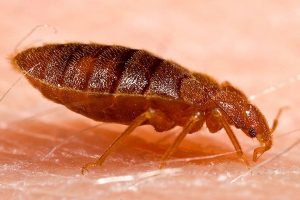 There has a n increase in bed bugs throughout the United States in the last twenty years. There was a time when bed bugs were nearly eradicated in the United States. However due to the increased amount of travel, the incidence of bed bugs is increasing.
There has a n increase in bed bugs throughout the United States in the last twenty years. There was a time when bed bugs were nearly eradicated in the United States. However due to the increased amount of travel, the incidence of bed bugs is increasing. 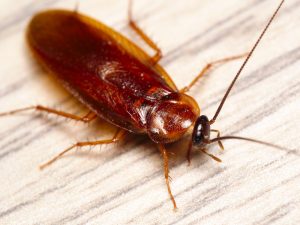 Cockroaches are most people’s nightmare. The idea of them invading your home and crawling across you dishes and plates can be horrifying. However, some people find them fascinating. Here are ten fact about cockroaches that you may not know.
Cockroaches are most people’s nightmare. The idea of them invading your home and crawling across you dishes and plates can be horrifying. However, some people find them fascinating. Here are ten fact about cockroaches that you may not know.
 Ants are prevalent throughout the world. The industrious insects work together to form a colony. Many people are fascinated by ants and all that they do. Here are 10 interesting facts about ants.
Ants are prevalent throughout the world. The industrious insects work together to form a colony. Many people are fascinated by ants and all that they do. Here are 10 interesting facts about ants.
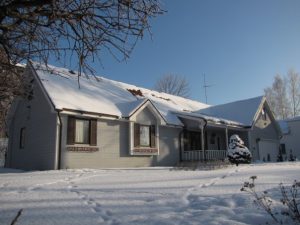 With winter coming temperatures are dropping. This can mean an increase in your power bill. It can also mean that different parts of your home are more vulnerable. It is important to take the time to winterize your home so that you can keep your home and family safe and protected. Here are five things you can do to winterize your home.
With winter coming temperatures are dropping. This can mean an increase in your power bill. It can also mean that different parts of your home are more vulnerable. It is important to take the time to winterize your home so that you can keep your home and family safe and protected. Here are five things you can do to winterize your home.